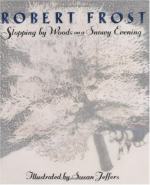|
This section contains 1,099 words (approx. 4 pages at 300 words per page) |

|
SOURCE: Gerber, Philip L. “The Appropriate Tool: Frost’s Craftmanship.” In Robert Frost, pp. 66-88. Boston: Twayne Publishers, 1982.
In the following excerpt, Gerber analyses “Stopping by Woods on a Snowy Evening” in terms of its formal, metrical elements.
“Stopping by Woods on a Snowy Evening” is widely regarded, metrically, as Frost's most perfect poem. He himself always offered it as the prime example of his commitment to convention, describing it as “my heavy duty poem to be examined for the rime pairs.”1 Frost said that he wrote it after an extended night of work on his long poem “New Hampshire.” Whether it was inspired by “auto-intoxication” and sheer tiredness, as its author suggested, or by some more ethereal influence, it has come to be the single poem with which most readers identify Frost.
Whose woods these are I think I know. His house is in the village though...
|
This section contains 1,099 words (approx. 4 pages at 300 words per page) |

|


